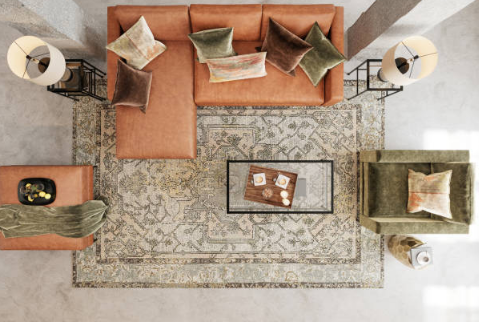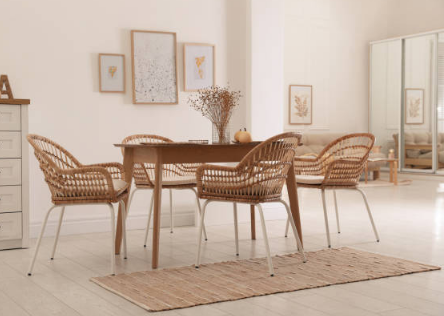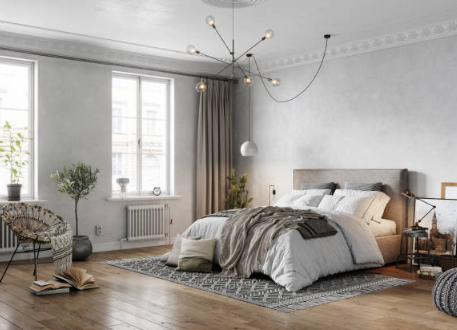
How to Clean and Deodorize Carpets with Baking Soda
January 28, 2024
Why Your Small Carpet Needs a Rug Pad
February 9, 2024There are many benefits to using a rug at home. Whether it’s to introduce anchor focus, create cohesion and personality, or for comfort, warmth, or noise reduction, these floor coverings are both practical and stylish. But if you make a mistake in carpet size, it can turn the room from delicate to unbalanced.
While carpet size rules are flexible (and can offer unique customization options), these room-by-room tips will help you avoid basic measurement mistakes, regardless of the size or design of the space.

A Rug Size Guide for Any Room
One of the biggest no-nos in the newbie area rug is that it’s too small. In general, the larger the rug, the more impact and unity it has. Getting bigger also makes a small space look bigger. In terms of size, some other considerations for general area rugs include:
- In general, all four legs of the main central furniture should be able to rest on the carpet, or at least the first two legs should be able to rest on the carpet.
- Consider the shape and size. For example, a round rug underneath a round table looks more cohesive.
- The carpet should have the same floor space on all sides, typically 6 to 24 inches away from the furniture.
- Maintain at least 10 to 24 inches of clearance between the carpet and the wall to create a more spacious atmosphere.
- It is advisable to measure carpet with painter’s tape to better help you visualize how dimensions work.
Living Room
When choosing a rug for your living room, the size and location associated with the layout of the furniture are crucial factors. Most commonly, the design incorporates key pieces of furniture with all four legs resting on the carpet. It’s also possible to just put your front legs on the carpet, and in a small space, you might just put the coffee table on the carpet.
Here are some standard living room rug sizes and details on when you might need to use them.
10 x 14 Foot Rug
These babies with strong personalities are perfect for larger living rooms, and you want to unify the space by mounting all the seats on them and leaving enough clearance at the edges.
9 x 12 Foot Rug
If you’re willing to put the front legs of your chair and sofa on the carpet, then this might be for you. It still unifies the space, but you’ll be cutting your budget, making it an ideal option when the space or layout makes it impractical to use a larger rug. An 8 x 10 foot rug is also suitable for this case.
6 x 9 Foot Carpet
In a small living room with limited space or budget, you can choose a compact rug that floats in the center of the seating arrangement or just under the coffee table. A small, centered and intentional floor covering can still add warmth and cohesion. A 5 x 7 foot rug is also suitable for this purpose, and it is ideal for sitting in front of the fireplace.
Kitchen
Kitchens aren’t always the first choice for adding rugs, as they often experience spills and stains. However, if you have an easy-to-clean option, they can add a warm and practical non-slip surface to your tile floor. A slide or rug in front of a function space such as a sink is often the best choice.

5 x 7 Foot Carpet
If you’re lucky enough to have a spacious but chilly kitchen (over 150 square feet) and don’t want to invest in underfloor heating, why not put a larger rug between the cabinets?
2 x 9 Foot Runner
Putting down a slide in the long kitchen can make the room look more spacious. This technique also applies when placing a long rug or 5 x 8 feet (or similar) rug in front of a long kitchen island. Make sure the runner extends the entire length of the island to avoid an awkward, misaligned appearance. Runners on both sides of the island can work in the more spacious kitchen.
3 x 5 Foot Rug
Smaller kitchens may not be able to accommodate sturdy rugs, but half-moon or rectangular cushions in front of the sink can provide extra padding and comfort. In the tightest spaces, a compact 2 x 3 foot rug may be better.
Dining Room

If you’re arguing about the size of your restaurant’s carpet, remember the golden rule of choosing a rug that can fit your table and all your chairs and still has at least 8 inches of clearance on either side. Ideally, when you pull the chair out, the chair should still be on the carpet and the legs should fit when the retractable table is at full length. There’s nothing worse than something shaking when you want to eat.
9 x 12 Foot Rug
If you have a large family or love to entertain, you may need a 9 x 12 foot or even 10 x 14 foot rug to fit under a table for eight or more people. 8 x 10 feet is usually perfect for a table of six.
8 x 8 Foot Carpet
Choose an 8 x 8 foot or 6 x 6 foot rug for a round or square dining table. When measuring, remember to add a few feet in order to pull out the chair.
6 x 9 Foot Carpet
For a rectangular dining table for four, a 6 x 9 foot or 5 x 8 foot rug will do. These tables are usually round, so choosing a round rug can unify the space.
Bedroom
Wake up on a cold morning and step on a soft foot-warming rug. Which rug size you choose in the bedroom largely depends on the size of your bed. And don’t forget to consider things like a bedside table nearby. Do you want to put the rug underneath these too?

10 x 14 Foot Rug
If you want to place a rug under the king-size bed and the bedside table next to it, choose a larger rug. It will give your room a grandiose, luxurious feel.
9 x 12 Foot Rug
9 x 12 feet is usually the ideal carpet size under a queen size bed. If you’re willing to put your hind legs and nightstand on the carpet under your king-size bed, then it can also do a job.
You want the rug to extend at least 18 inches beyond the sides of a king or queen bed.
8 x 10 Foot Carpet
If you like to put your back legs and bedside tables on the carpet when using a queen size bed, then this is the best size. It can also place the main furniture on the carpet of the twin room with a central bedside table. In this case, you want the rug to be large enough to allow 12 inches of clearance on either side of the twin beds.
2 x 9 Foot Runner
You can place a pulley in the bottom of a queen bed or two single beds. Or, for a budget-friendly frame idea, invest in two slides mounted on either side of the bed.
Bathroom
A washable bathroom rug will allow you to catch those droplets that cause slippage and keep your toes warm as you step out of the tub or shower. But you don’t want the rug to take up space in these smaller rooms. Here are some standard bathroom rug sizes.

5 x 8 Foot Carpet
The spacious master bathroom should be a little larger, and the shape should also be considered. Round rugs can soften sharp lines in bathroom design. A large rug like this can also be placed underneath a freestanding clawfoot tub.
2 x 6 Foot Runner
The treadmill is perfect for stretching under a double vanity or along the length of a narrow bathroom.
3 x 5 Foot Rug
Smaller 3 x 5 feet or 2 x 3 feet rugs are a great option for adding personality or warmth to a compact powder room. They are also perfect for sitting under the sink, toilet, or shower in a small bathroom. You can even take two – one under each sink of the double vanity.
Hallway
A running rug may be the go-to option in long hallways and is ideal for wiping off wet shoe prints, but there are other rug options for this space. When considering size, be sure to consider the pile height and length – you don’t want your rug to get in the way of your front door opening.

2 x 9 Foot Runner
For long, narrow hallways, a 2 x 9 foot or 2 x 6 foot slide is the obvious choice, especially if you can place all of your furniture legs on the carpet (which is a more widely accepted room). When choosing a size, don’t forget to leave enough borders on the edges of the carpet – the width of the door is a good baseline.
3 x 5 Foot Rug
A 2 x 3 foot or 3 x 5 foot mini rug is perfect for sitting at the front door to “wipe your feet,” especially if your entrance is small.
5 x 8 Foot Carpet
If you have double doors, you may need a larger rug to cover the width of the entryway. This thick rug will give your guests the perfect soft and stylish welcome.




